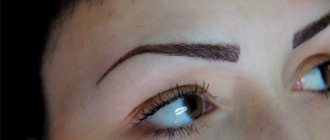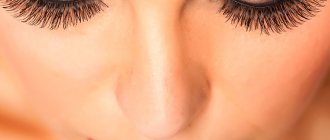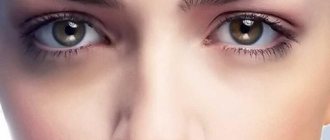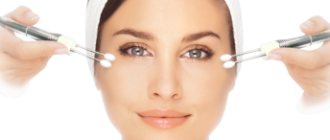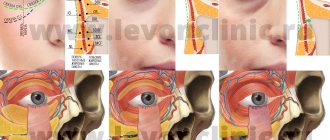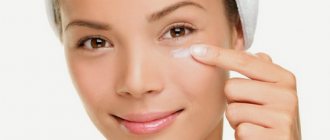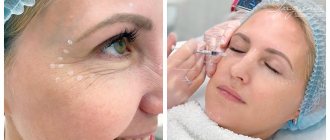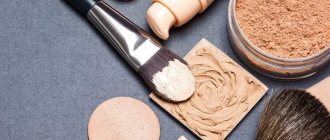Swelling of the eyelid is a common condition that is a concomitant symptom of many diseases. To treat it, ophthalmologists use different means. These include drug therapy, physiotherapeutic procedures, and surgical interventions. Some people prefer to rely on traditional medicine to treat edema.
In this article
- What is eyelid swelling?
- Why do my eyelids swell?
- Treatment of eyelid edema using traditional medicine
- Is it possible to use folk remedies for swelling of the eyelids?
- How can you relieve eyelid swelling using folk remedies?
- Relieving edema using folk remedies of animal origin
How to remove swelling from the eyelids?
Swelling occurs due to the accumulation of a large volume of fluid in the intercellular space. The skin around the eyes is the thinnest.
In this article
- How to remove swelling from the eyelids?
- The most common causes of eyelid swelling
- How to relieve swelling of the eyelids after drinking alcohol?
- Eyelids are swollen after tattooing - what to do?
- How to remove swelling from the upper eyelid using folk remedies?
- How does massage help remove swelling from the upper eyelids?
- How else can you remove swelling from your eyelids?
Because of this, swelling appears on the eyelids or under the eye sockets. Other parts of the body also swell, but on the face it becomes immediately noticeable. Swelling of the eyelid or eye is not only a cosmetic problem. This symptom may signal the development of a disease, not necessarily related to the organs of vision. Let's look at all the possible causes of eyelid swelling and find out how to remove them.
Treatment of eyelid edema using traditional medicine
Therapy for edema is aimed at identifying the causes of this condition. Since swelling is usually an accompanying symptom, it is very important to establish the root cause of its occurrence. If the formation of edema is associated with an inflammatory process that was caused by an infection, the ophthalmologist will prescribe antibacterial or antiviral drugs. These can be eye drops and ointments. For inflammatory swelling of the eyelid, doctors often prescribe physiotherapy. Mesotherapy or blepharoplasty can be performed. These are cosmetic procedures that allow you to tighten the skin of the eyelid.
If eye swelling is not due to inflammation, then doctors prescribe treatment only after the nature of the disorder is identified. If the formation of swelling is caused by improper sleep patterns or lack of nutrients due to diet, then applying a cold compress, taking diuretics or lymphatic drainage massage will help relieve the swelling. The cause of swelling of the eyelids is sometimes associated with fatty hernias. In such cases, doctors prescribe surgical treatment. Removing excess areas of fatty tissue allows you to get rid of swelling.
When allergic edema forms, treatment is not prescribed so often. In most cases, it goes away on its own. If the swelling is severe, the patient is prescribed antihistamines. For severe forms of allergies that are accompanied by other diseases, steroid medications may be recommended. It is very important to establish what caused the swelling of the eyes and to identify the allergen through testing. Limiting contact with it allows you to quickly relieve swelling and speed up the healing process. It also helps prevent relapses of inflammation in the future.
It is possible to relieve swelling of the eyelids, which is the result of injury, damage to the soft tissues around the eyes, by eliminating the traumatic lesion. If there is no open wound, then cold compresses are allowed to be applied to the damaged areas of the skin. The subsequent stages of treatment consist of local treatment of the swelling. For this, ophthalmologists prescribe anti-inflammatory drugs. If tests show that an injury caused bacteria to enter the body, then doctors will additionally recommend antibacterial medications. They help prevent infection of the damaged skin area.
Medical treatment includes the use of eye drops and ointments. The doctor selects them in accordance with the cause of eyelid swelling. The most common and effective drugs that are usually used to relieve swelling are:
- "Tobrex";
- "Indocollier";
- "Prednisolone";
- "Hydrocortisone";
- "Allergodil";
- "Opatanol";
- "Visine."
Before prescribing medications, the ophthalmologist carefully examines the patient’s medical history and inquires about the presence of chronic diseases. Sometimes consultation with a specialist is required, for example, a nephrologist, cardiologist, allergist and others. You should not start treatment on your own.
What causes swelling of the eyelids and what should be done to relieve it?
Swelling may occur in one eye or both. In such cases, they speak of unilateral or bilateral edema, respectively. Most often the upper eyelids swell. This can happen for various reasons - pathological and non-pathological. The first group of factors includes eye diseases and diseases of other organs. Swelling of the eyelids is almost always observed with the development of inflammatory ophthalmopathologies. Among them:
- keratitis;
- blepharitis;
- conjunctivitis;
- iridocyclitis;
- barley.
The eyelids also swell with some systemic ailments - diseases of the kidneys, liver, blood vessels, diabetes mellitus, allergies, abdominal dropsy. Swelling of the upper eyelid is a very common symptom that cannot be called specific. It is difficult to determine from this sign alone whether it is a consequence of any pathology. However, often the eyelids swell for reasons that are not related to disease.
Diseases in which symptoms may be observed
Swelling of the upper eyelid is considered pathological when such a disorder is caused by some disease. Among these ailments, the most common are:
- Blepharoconjunctivitis . A disease that combines conjunctivitis (inflammation of the eye lining) and blepharitis (inflammation of the edge of the eyelid).
- Hemophthalmos. Hemorrhage into the vitreous body, which occurs most often as a result of other eye diseases. This is a fairly rare disorder that affects blood vessels, including the part of the circulatory system located in the upper eyelid.
- Conjunctivitis. The most common infectious or non-infectious lesion of the mucous eyes among all age groups. In such cases, the eyelids swell and take on a pronounced red color. Additional symptoms depend on the type of disease (allergic, bacterial, viral and others).
- Trachoma. An infectious chronic disease caused by chlamydia. Often in the early stages of development, the symptoms of the disease are mild or completely absent, and swelling of the eyelids appears last.
- Tuberculosis of the eye . An infectious disease caused by the tuberculosis bacillus. This pathology rarely develops independently and is mainly a complication of pulmonary tuberculosis.
- Endophthalmitis. An inflammatory disease that spreads to the internal structures of the organs of vision. As a result, purulent discharge accumulates in the tissues of the eyes and in the glands located in the eyelids. With endophthalmitis, the patient's vision is significantly impaired, swelling appears well, and the eyelids thicken and acquire a pronounced red tint.
The most common causes of eyelid swelling
Swelling of the eyelids appears due to hormonal imbalances, as a result of visual fatigue, injury, after an insect bite, due to prolonged exposure to ultraviolet radiation on the eyes and skin.
In some cases, swelling occurs briefly after taking certain medications. However, the most common causes of edema are:
- alcohol consumption;
- poor nutrition;
- tattoo;
- overwork.
Let's look at these reasons in more detail and list ways that help quickly remove swelling.
Homemade face masks
When the face swells and looks “puffed up,” masks come to the rescue. You don't have to buy them at the store; you can make them yourself.
Fabric and hydrogel masks
These are the most popular types of face masks today because they are easy to use and give amazing results. The difference between hydrogel masks is the presence of a sticky component, which improves contact with the skin.
All types of masks are impregnated with special components - one or more. These can be plant extracts, essential oils, hyaluronic acid, callogen, algae and other components.
The mask can be applied both morning and evening, but the skin must be clean. The bag is opened, the mask is carefully applied to the face, fixed, and the person must lie with it for as long as indicated in the instructions. The frequency of using the mask is from 1 to 7 times a week.
Among the most famous manufacturers of face masks are Garnier, Lancome, Kiehl's, Compliment. It’s very easy to choose “your” option: the packaging says the purpose of the mask (moisturizing, nourishing, anti-aging) and the features of use (for dry, oily, problem skin).
Pumpkin mask
The pumpkin mask contains vitamins and beneficial microelements that make the skin smooth, soft, elastic and clean. You can buy a pumpkin mask in a store or prepare it at home using the following recipe: mix 3 tbsp. steamed pumpkin, 1 tsp. honey, 1 egg yolk. The mass is thoroughly mixed and applied to cleansed skin for 15-20 minutes.
Nourishing mask
The skin, like any organ of the human body, needs nutrition.
You can get a healthy and nourishing face mask from the following ingredients:
- 100 g of natural yogurt without additives;
- 1 tbsp. honey;
- zest of 1/2 grapefruit.
The mixture is mixed well and applied to the face and décolleté for 20 minutes. Remove the mask gently using a moistened cotton pad.
Firming mask
The lifting effect is the most popular request from women with aging skin (40+). You can make a tightening face mask at home: you don’t have to go to a cosmetologist for rejuvenation. A similar effect can be achieved by mixing 1 teaspoon of aloe juice with the same amount of lemon juice. The liquid mass is applied to the face for 20-30 minutes.
Chocolate mask
Chocolate has a rejuvenating effect on facial skin.
The mask is prepared as follows: half a chocolate bar (50 g) is melted in a water bath. When the mass has cooled a little, it is applied to the face and décolleté for just 10 minutes. Then you need to wash your face with warm water and apply moisturizer.
Apple mask
Apple perfectly nourishes, moisturizes, tones and rejuvenates the skin. In addition, with the help of such a mask you can get rid of acne and oily shine.
A universal mask for any skin type: peel the apple, grate it and mix with 1 tbsp. olive oil. The mixture is applied to the face for 10-15 minutes.
Milk mask
If you have milk at home, you can do this: soak a cotton pad in it and wipe the skin of your face, décolleté and area around the eyes. It is better to do this in a horizontal position and lie down for 15-20 minutes. The temperature of the milk should be comfortable: not too high and not too low.
Mint leaf mask
Mint improves complexion, fights inflammation and irritation, reduces acne and wrinkles, nourishes, tones the skin and regulates the activity of the sebaceous glands.
For the mask you will need 1 tbsp. fresh mint leaves, 1 tsp. honey, a few fresh strawberries. Mint and strawberries are grated, mixed with honey, and the resulting mask is applied to the face for 20 minutes.
Moisturizing mask
A moisturizing face mask is prepared from 1 carrot, grated on a coarse grater, and 1 chicken yolk. While the mixture is on the face, the skin receives a large dose of vitamins, softens, moisturizes, and thanks to vitamin C, its own collagen is produced.
Cucumber mask
The cucumber mask is suitable for daily use. It refreshes the appearance well and nourishes the skin. It is recommended to apply thin round cucumber slices to steamed facial skin in the evening and leave for 20-30 minutes. There is no need to wash your face after this.
Anti-edema mask with coffee
The coffee mask copes well with swelling and gives the skin elasticity.
It is prepared by mixing 2 tbsp. coffee grounds, 2 tbsp. oatmeal and 10 ml sour cream or natural yogurt. It is recommended to apply the mixture 2 times a week in the morning or before bed, and keep it on for no more than 10 minutes.
Potato mask
Potato mask can be made in two ways:
- Cover your face and décolleté with thin potato rounds;
- Prepare a paste of grated raw potatoes, wrap in gauze and place on your face.
This is also one of the cheapest, fastest and most accessible ways to remove swelling.
Parsley anti-edema mask
It is better to choose fresh parsley and immediately chop it with a knife or using a blender. Greens can be mixed with sour cream or cottage cheese and applied to the face for 15-20 minutes. Facial swelling will go away immediately.
Anti-edema mask with starch
For this mask you will need:
- 30 g dry potato starch;
- 75 ml freshly squeezed carrot juice;
- 25 g sour cream;
- 500 ml water.
First, water is mixed with starch and heated over low heat, stirring constantly. The mixture does not need to be brought to a boil! Then starch water is mixed with carrot juice and sour cream and applied to the face in several layers: as soon as one dries, another should be applied immediately.
As a result, the mask should remain on the face for as long as possible until all the prepared solution is used up.
How to relieve swelling of the eyelids after drinking alcohol?
After drinking alcohol-containing drinks in large quantities, not only the eyelids, but also the entire face swells. With chronic alcoholism, swelling occurs in the legs and arms, which already indicates the development of severe pathologies of internal organs. The main cause of edema is the inability of the liver to process ethyl alcohol into components that would be harmless to the body. Also, swelling may indicate poor functioning of the urinary system, which leads to fluid stagnation.
Swelling usually goes away within a day or 24 hours. The speed of recovery depends on several factors:
- amount of alcohol consumed;
- frequency of drinking alcoholic beverages;
- person's age;
- condition of internal organs;
- genetic characteristics;
- body weight.
Edema can also occur in people who rarely drink. It depends on the body. Sometimes a feast cannot be avoided. Many people drink alcohol at corporate events and then have to go to work the next day. In the morning you saw that your face and eyelids were swollen, and you somehow needed to leave the house. What to do in this case? Women who are more concerned about this problem than men can hide puffiness under makeup. In principle, swelling will go away on its own within one or two days. It is only necessary to restore the balance of salts and fluids in the body, as well as get enough sleep.
Prevention
If we talk about non-pathological swelling under the eyes, you can avoid them or reduce the likelihood of their development as follows:
- follow the rules for wearing and storing contact lenses and promptly replace such products upon expiration;
- do not eat salty, spicy, fried foods before bed and drink less liquid;
- in the autumn-spring period, to strengthen the immune system, take vitamin complexes ;
- monitor the body's reaction to various potential allergens and exclude contact with them.
You should also be careful about your eye health and observe good personal hygiene.
Note! If you notice the first signs of ophthalmic diseases, you should immediately undergo examination by a specialist.
And people aged 35-40 years old need to undergo such checks regularly (at least once a year), since some pathological processes can go unnoticed in the initial stages.
Eyelids swell in the morning - what is the reason and how to remove the swelling?
If your eyelids are swollen after sleep, most likely the reason for this is poor nutrition. A late dinner consisting of smoked or too salty foods makes you thirsty.
A person drinks one or two extra glasses of water before bed, and wakes up in the morning with a swollen face. Usually there are bags or bruises under the eyes. Some people experience swelling of the upper eyelids. Also causes of swelling can be:
- lack of sleep;
- cosmetics that are not washed off before bed;
- smoking;
- overwork;
- stress;
- cry.
All these factors are not associated with diseases, so you can eliminate swelling yourself at home. You can quickly relieve swelling caused by the above reasons using cosmetic procedures, massage, ice and other means, which we will discuss later.
Causes of puffy eyes in the morning
The causes can be both harmless factors and various diseases. Usually, if we are talking about physiological reasons, edema appears in isolated cases, but in pathologies it bothers you day after day.
Ophthalmological
Speaking about eye diseases and various inflammations that cause swelling of the eyelids, the following are distinguished:
- conjunctivitis;
- barley;
- swelling of the eyelid;
- dacryoadenitis;
- tumors of the lacrimal glands;
- blepharitis.
Conjunctivitis is an inflammatory disease of the outer mucous membrane of the eye and the inner surface of the eyelids. Any pathogenic microorganisms can provoke inflammation: viruses, bacteria, fungi and even allergens.
REFERENCE! Only a doctor can identify the type of disease and prescribe treatment after conducting a full examination and interview of the patient.
Typically, conjunctivitis is accompanied by redness of the eyes, profuse tearing, swelling, formation of lumps, growths and discharge of pus.
Barley is a well-known inflammation with the formation of an infectious compaction. In this case, the edges of the eyelids turn red, the eyelids themselves swell, and the separation of purulent and tear fluids increases. When touched, discomfort and pain occur, and there is a disturbing sensation of a foreign object in the eye.
It is interesting that at the initial stage of the disease the lesion itself is not visible, and sometimes it is difficult to palpate. A person wakes up in the morning with the feeling that something has got into the eye, and discovers swelling and redness of the eyelids, usually of one eye.
Edema of the eyelid is a disease characterized by the accumulation of a large amount of fluid under the skin of the eyelid. The main symptoms are redness and swelling of the eyelids.
Dacryoadenitis is an inflammatory disease of the lacrimal glands, in which the gland sharply swells, causing the eyelid to become red, thickened and swollen. It is impossible not to notice the signs of the disease, so you should immediately contact an ophthalmologist. In the absence of timely treatment, dacryoadenitis quickly becomes chronic.
Tumors of the lacrimal glands are diagnosed when their cells grow abnormally. A person may experience discomfort when blinking and headaches, pain when rotating the eyeballs, and blurred vision. Among the symptoms of benign or malignant neoplasms is swelling of the eyelid.
Finally, blepharitis is an ophthalmological diagnosis characterized by inflammation of the edges of the eyelids. Classic signs of blepharitis are swelling, redness, itching and burning of the skin of the eyelids, watery or dry eyes, pain after sleep, the appearance of dry crusts or purulent discharge.
Diseases of internal organs
Sometimes the eyes reflect the state of the internal environment of the body and indicate the occurrence of any pathological processes. Usually there are accompanying symptoms and swelling of the eyelids appears regularly. If you notice swelling of your eyes for several days in a row, you should go to the doctor.
What diseases can swelling of the eyelids indicate?
- Pathologies of the cardiovascular system. In this case, accompanying symptoms are swelling of the arms, legs and face, tachycardia, shortness of breath, sharp chest pain, dizziness, surges in blood pressure, and coldness of the extremities. Only one eye may become swollen.
- Allergy . Allergic reactions often develop allergic conjunctivitis, which is characterized by tearing, redness and swelling of the eyelids. Itching and skin rashes also often appear. If contact with an allergen occurs at home and a person cannot detect it, swelling of the eyes will bother them in the morning.
- Kidney diseases . In various diseases of the excretory system, they speak of a violation of the removal of fluid from the body. When it comes to kidney pathologies, swelling occurs mainly in the morning and spreads to the entire body (arms, legs, back, face). A characteristic sign is a change in the color of urine.
- ENT diseases. The close proximity of the nasopharynx and eyes cannot be denied. If a person has one of the inflammations of the ear, throat or nose (sinusitis, sinusitis, otitis media), the infection can spread and affect the mucous membrane of the eye, resulting in swelling.
- Dental diseases. In very advanced cases of dental problems, when we are no longer talking about caries, but very deep damage to bone tissue, inflammation can reach distant areas, which manifests itself in the form of swelling of the eyes.
- Hormonal changes. This problem often occurs in pregnant women, since under the influence of hormones the functioning of internal organs, including the kidneys, is disrupted.
If you notice at least one strange symptom, other than swelling of the eyelids, you need to undergo diagnostics.
The effect of drinking liquid on the appearance of swelling
Swelling is directly related to the amount of liquid drunk the day before, including tea, liquid broths, and sodas. It is necessary to drink water, but if you regularly drink too much, swollen eyes will begin to bother you in the morning.
Drinking a lot, especially before bed, leads to the fact that the vessels cannot hold such an amount of liquid. As a result, it enters the intercellular space and is distributed into free spaces, hence the swelling.
REFERENCE! The desire to drink a lot of water is often present among lovers of salty, hot, spicy foods, as well as among supporters of strict diets and fasting.
An equally important factor is water temperature. If a person is a supporter of cold, almost ice-cold drinking, he is more prone to swelling, since the body spends a lot of energy heating the water to a comfortable temperature, and almost begins to work worse.
What is the connection between puffy eyes and alcohol?
Ethyl alcohol, which is contained in alcoholic drinks, negatively affects the urinary system. Even a small dose of alcohol impairs kidney function and contributes to swelling of the face and eyes.
Chronic swelling is found in people who lead a hard-drinking lifestyle and heavy alcoholics.
The impact of working on a computer
Today, manufacturers of digital equipment have learned to make screens for monitors, tablets, laptops, and phones that practically do not harm the eyes. And although radiation has indeed become safer, after working at a computer for a long time, especially if you are not used to it, your eyes become red, swollen and look painful.
The mechanism of this reaction is determined by the fact that when looking at images on the monitor, a person is forced to concentrate his gaze on certain objects (letters, labels, icons), due to which the blinking frequency is often reduced.
Infrequent blinking is the key to drying out the tear fluid and thinning the protective membrane of the eye. The eye becomes more vulnerable to radiation, its sensitivity decreases, and blood circulation worsens. Since metabolic processes are inhibited, the products of these processes begin to accumulate in the tissues of the visual analyzer, causing the eyes to become very swollen.
IMPORTANT! When the tear film becomes thinner, a person begins to peer even more diligently into the image, provoking another decrease in sensitivity and stagnation. All this resembles a vicious circle.
Eyelids are swollen after tattooing - what to do?
Tattooing is a cosmetic procedure that is very popular today. It is performed in beauty salons only by qualified specialists. Usually, materials that are safe for health are used, so tattooing does not cause side effects. However, no one is safe from them either.
The causes of eyelid swelling after tattooing can be:
- failure to comply with the cosmetologist’s instructions after the procedure;
- use of low quality pigment;
- too dry or thin skin;
- allergic reaction to dye;
- infection under the skin.
Eyelid or eyebrow tattooing is performed using a cosmetic instrument that comes into contact with the skin. Dye is injected underneath it. In this case, the integrity of the skin is compromised. As already noted, facial skin is very thin and sensitive. Any irritating factor can cause swelling under the eyes or on the eyelids. There is a risk of developing an inflammatory process, which is, of course, rare if the procedure is performed in a good salon.
Tissues react to the pigment as if it were a foreign body. Slight swelling is normal after insertion. Also, some patients complain of pain, itching, redness of the eyelids or eyebrows. However, there should not be severe swelling. Temporary swelling subsides during the first 24 hours after the procedure. If this does not happen, you need to consult a doctor.
How to remove swelling in such cases? It is not recommended to eliminate the symptom yourself until a specialist determines the cause of its occurrence.
Why do my eyelids swell?
There are quite a few reasons why facial swelling occurs. One of them is an increase in pressure in the capillaries, which are the thinnest blood vessels. The permeability of capillaries is often impaired due to intoxication of the body, inflammatory processes, and malfunctions of the nervous system. All this can also lead to swelling of the eyelids. The reason why this condition often develops is a decrease in protein levels. Because of this, the pressure of the blood plasma decreases, and fluid from the blood vessels enters the adjacent tissues. Usually pathological disorders lead to these processes, for example:
- endocrine diseases: diabetes mellitus, hypothyroidism; obesity;
- ophthalmological pathologies: conjunctivitis, keratitis, chalazion, blepharitis;
- cardiovascular diseases: arterial hypertension, vegetative-vascular dystonia, arrhythmia, angina pectoris, endocarditis, ischemia, aortic aneurysm;
- bacterial lesions: rhinitis, pharyngitis, sinusitis, meningitis, encephalitis, demodicosis, pneumonia, phlegmon;
- nephrological abnormalities: nephritis, pyelonephritis, nephrolithiasis, glomerulonephritis, nephroptosis, hydronephrosis;
- allergic pathologies: Quincke's edema, hay fever, furunculosis;
- injuries that are accompanied by subcutaneous hemorrhage;
- disturbance of lymphatic flow and water-electrolyte balance;
- taking certain categories of medications, such as salicylates and sulfonamides;
- incorrect body position during sleep and venous stagnation;
- bad habits: smoking, drinking alcohol.
Other circumstances can also lead to the formation of swelling in the eye area. Often this condition is a consequence of tattooing. Usually, after this cosmetic procedure, the swelling of the eyelid disappears the very next day. If this does not happen, then it is likely that complications have arisen. This usually happens if the paint used causes an allergic reaction or the skin is very sensitive, and a violation of its integrity leads to the formation of edema. To perform tattooing, cosmetologists often use anesthetics, which can provoke the development of swelling of the eyelid.
Swelling is often a consequence of excessive salt intake. This food product retains water in the body. Therefore, diets that are designed to reduce eye swelling usually completely exclude pickles, smoked foods and other foods that are prepared with a lot of salt. Swelling on the face occurs due to the fact that sodium chloride leads to swelling of tissue colloids due to increased “absorption” of fluid. Determining the reason why the eyelid is swollen is very important. The selection of treatment tactics and its effectiveness depend on this.
How to remove swelling of the eyelids?
Swelling from the eyelid can be eliminated at home, in a clinic or in a salon. It all depends on what is causing the symptom, whether you have the time and money or not. If the nature of the swelling is pathological, then you first need to see a doctor. Typically, swelling of the eyelids as a symptom of the development of an eye disease is accompanied by the following signs:
- hyperemia or pallor;
- transillumination of blood vessels;
- lacrimation;
- itching and burning;
- thickening of the cartilage of the eyelid;
- pain;
- discharge of mucus or pus.
If you have several of these symptoms, you should see an ophthalmologist. It is dangerous to relieve swelling from the eyelid using folk remedies or medicines that are in your home medicine cabinet. The disease may become more complicated. If you are sure that swelling of the eyelid is not a consequence of the development of the disease, you can use the recipes of the so-called traditional medicine. Let's find out what you can urgently do to get rid of puffiness.
Cosmetics to eliminate swelling
To effectively eliminate puffiness, it is recommended to use those cosmetics for the skin around the eyes that contain caffeine, which improves blood circulation in the tissues. Additional hydration can be achieved by adding vitamin E, essential oils, grape seed extracts, parsley, and rice bran to the product.
Cosmetic patches soaked in moisturizing and toning ingredients - aloe juice, glycerin - will help you get rid of swelling of the eyelids in a short time. Upon contact with the skin, all substances penetrate the skin, tighten it, improve lymph flow and blood circulation. Apply cosmetic patches every day at night or in the morning.
How to remove swelling from the upper eyelid using folk remedies?
You can quickly get rid of swelling of the eyelids with the help of lotions, compresses and face masks. They do not cure diseases, but help soothe the skin and muscles, which promotes the outflow of excess fluid. On the Internet you can find many recipes that are used to relieve swelling of the eyelids. Let's list some of them:
- Cold. Everyone has ice cubes in their refrigerator. They need to be wrapped in gauze or bandage and applied to closed eyelids for 1-2 minutes. The eyes should not be too cold. It is better to apply ice to the eyelids intermittently.
- Carrot. Make a mask from the grated vegetable. You can apply it not only to the upper eyelids, but also to the skin under the eyes, the bridge of the nose, and cheekbones.
- Flax seeds. They need to be filled with hot water and left overnight. The resulting broth is filtered. Lotions are made from it and applied to the eyelids for 10-15 minutes. This remedy is believed to help with swelling and inflammation. However, if there is an inflammatory process, it should be treated by a doctor.
- Tea with mint. Tea may have a decongestant effect. Tea compresses are applied to the eyes for 15-20 minutes. Instead of tea leaves, you can also use plants such as chamomile, calendula, thyme, fireweed, and sage.
- Chilled milk. Tampons are moistened in it and left on the upper eyelids for 20-25 minutes. Also, some supporters of traditional medicine suggest using other dairy products - cottage cheese or sour cream.
- Raw potatoes. It can be cut into circles or grated on a fine grater to make compresses.
- Egg white. It has an astringent effect. Apply to eyelids for 15-20 minutes, then wash off with warm water. Daily use of eggs in this way helps smooth out wrinkles on the eyelids.
These products help to slightly eliminate swelling. There are more effective methods. Let's find out how to remove swelling from the upper eyelids using massage.
Treatment depending on the causes
eyelid swelling symptomatically , trying only to eliminate this symptom.
Attention! It is necessary to accurately diagnose the cause of the development of such a disorder and deal with this problem - if adequate treatment is prescribed, the swelling will quickly go away without taking special measures.
Regardless of the disease, the doctor can prescribe external decongestants - creams or ointments, which in most cases can quickly eliminate the symptom.
But in addition to their application, you should follow a course that involves the use of certain medications for various pathologies.
For barley
Infrequently, the upper eyelid may swell with a stye (sometimes such an abscess appears above the eye, although most often it forms on the lower eyelid).
The most rational thing to do with such a disease is to wait until the abscess opens on its own.
But in addition warming can be used anti-inflammatory drugs can also be used throughout the entire treatment period .
It’s worse if the stye develops not from the outside, but from the inside of the eyelid - in this case, ointments are applied from its inside, which can cause painful and uncomfortable sensations.
Also in such cases, ophthalmic solutions are instilled (not only anti-inflammatory, but also disinfecting, since if the abscess is opened, its contents fall on the mucous membrane and can cause inflammation).
How does massage help remove swelling from the upper eyelids?
If your upper eyelids are swollen after sleep or due to alcohol consumption, you can do a lymphatic drainage massage.
Similar services are provided in salons. The massage is performed with hands or a special device. Massaging the eyelids helps improve blood circulation and fluid outflow. After just one session, which lasts 15-20 minutes, the swelling noticeably subsides. Not everyone has the opportunity to visit expensive salons. If you urgently need a massage to quickly relieve swelling from the upper eyelids, perform it according to the following algorithm:
- wash your hands and face with soap;
- apply moisturizer or oil to the skin;
- Using your middle and index fingers, massage your upper eyelids in a circular motion from the outer corner of your eyes to the inner corner;
- apply a few light pressures to the eyeballs and pat the skin around them with your hands;
- Massage your eyelids, temples, and eyebrows in a circular motion.
The massage should be completed with a contrast wash. If you do it daily, swelling will rarely appear. However, it is necessary to consult a doctor before performing this procedure, as there are contraindications to it:
- eye injuries;
- postoperative period;
- chronic ophthalmopathologies;
- inflammatory diseases of the eyelids and eyes;
- cataract;
- glaucoma;
- retinal detachment.
Do not forget that swelling of the eyelids as a symptom of any illness can only be treated under the guidance of a doctor, so as not to aggravate the situation. You can resort to folk remedies and massage only if it is approved by a specialist, and swelling rarely occurs and is not due to disease.
Eye swelling due to allergies, what to do
In order to quickly relieve allergic swelling, it is necessary, first of all, to eliminate the effect of the factor that caused such a reaction (cosmetics, food, dust, animal hair, midge bite), and rinse the eyes with plenty of running water.
Then take an antiallergic drug or apply directly to the area of swelling. As a rule, antihistamines are used: Suprastin, Cetrin.
Cold compresses made from a piece of ice or frozen chamomile decoction have a good effect. You can also wipe the eyelid with a solution of novocaine or anesthesin. The area where the swelling has formed can be anointed with Prednisolone or Celestoderm.
Will eye exercises help remove swelling?
Special exercises to relax the eye muscles will help relieve swelling if it is not caused by illness. Eye exercises increase blood circulation and oxygen supply to tissues. This also helps eliminate swelling, although not as effective as lymphatic drainage massage. If desired, you can use several treatment methods at the same time.
Try the following exercises:
- move your eyeballs in different directions;
- close your eyes tightly and open your eyes wide, repeating this algorithm 5 times;
- massage the upper eyelids with your fingers from the bridge of the nose to the outer corner of the eyes and back;
- pull the lower eyelid up and relax, then repeat this with the second eyelid.
You can use other sets of exercises. It is better for your doctor to choose it for you, especially if you have vision problems. Gymnastics may be contraindicated in case of refractive errors, for which special exercises are selected. You should also not do exercises if you have inflammatory eye diseases, retinal pathologies, increased intraocular pressure and some other diseases.
Massage treatments
Massage will help remove swelling. Using light movements, lightly pressing on the skin, massage the eyelids with your fingertips for several minutes. The skin in this area is very thin, delicate and requires careful handling.
To achieve the best effect, you must use natural oils: grape seed, almond, peach or moisturizer. After the massage procedure, you should briefly apply cotton pads soaked in cold water.
In addition, it is recommended to perform some exercises:
- Squeezing your eyes shut. You need to close your eyes tightly for 5-7 seconds, then open your eyes wide. The exercise should be repeated 10-12 times.
- Circular rotation of the eyeballs. It is necessary to perform several rotations clockwise, then counterclockwise. At the same time, you should keep your head straight.
- Blinking. You should blink quickly and relax your eye muscles for 10-12 seconds.
- Complete the set of exercises with palming.
How else can you remove swelling from your eyelids?
For swelling, physiotherapeutic procedures may be prescribed. Some of them are available only in paid clinics. This method of treatment is the most effective of those listed. In several sessions of physiotherapy, it is possible not only to relieve swelling, but also to smooth out wrinkles, increase skin and muscle tone, and improve blood circulation in the eye area. The following procedures are applied:
- myostimulation;
- electrical stimulation;
- fractional thermolysis;
- cryotherapy.
There are contraindications to this treatment, so you will have to undergo an examination before the procedures.
How to prevent swelling
Naturally, you can get rid of this problem just by regularly leading a healthy lifestyle. If you are actively involved in sports, monitor the quality of your diet, do not indulge in alcohol, and do not allow stress to become the master of your life, then not only your eyes, but your entire body will thank you.
You will always look young and fresh, catching the admiring glances of others. If you follow these simple rules, a contrasting wash in the morning will be enough for you to look irresistible.
What happens if swelling is not treated?
Some people's eyelids always seem swollen, which is due to their structure or some congenital defect. In most cases, swelling goes away on its own without treatment. If swelling on the face is a frequent symptom that worries you, you need to make an appointment with an ophthalmologist. Pathological edema can, if left untreated, lead to the development of complications, including glaucoma. Also, constant swelling of the eyelids, if they block the pupil, can affect vision.
Prevention of edema includes the following rules:
- balanced diet, consumption of a small amount of salt and volume of water corresponding to body weight;
- rejection of bad habits;
- normal mode of work, rest and sleep;
- timely treatment of all diseases.
Swelling of the eyelids seems to be a harmless symptom, but if it occurs, it is better not to take risks and not to self-medicate, but to visit a doctor.
How to get rid of “bags” under the eyes using cosmetology?
It is faster and more expedient to remove pronounced fatty hernias of the lower eyelids if they have been present for a long time, as well as with excess stretched sagging skin and wrinkles (folds). Even several sessions with a cosmetologist may not lead to the desired aesthetic result. However, if puffy or fatty “bags” and “circles” under the eyes have been bothering you not so long ago, as well as the first signs of age-related skin changes (wrinkles, loss of tone), then you can fight them in the cosmetologist’s office. Let's talk about the most effective methods.
Injection cosmetology - MesoEye C71
What problems does it solve?
- Copes with persistent swelling;
- Removes noticeable “bags” (hernias) under the eyes, including eye bags;
- Removes dark circles;
- Removes wrinkles, including crow's feet;
- Noticeably refreshes a “tired look”;
- Effectively fights signs of age-related skin changes.
How many procedures will be required?
On average, 4-6. The result is visible after the first procedure.
Rehabilitation
Depends on skin sensitivity. Injections in the delicate and sensitive periorbital area, of course, cannot be called pleasant, but the micropapular technique allows you to not be a red panda after just 1 day 
Lymphatic drainage massage
What problems does it solve?
- Removes lymph and excess fluid, thus relieving swelling;
- Strengthens the skin around the eyes, enriching it with oxygen and stimulating the production of its own collagen and elastin;
- Smoothes out wrinkles;
- Returns tone to sagging skin.
How many procedures will be required?
A lasting and pronounced effect requires more than 4 procedures. Can be combined with home eye care.
Rehabilitation
No
Home care Follement Professionnel (France)
What problems does it solve?
- Noticeably reduces swelling under the eyes, has a drainage effect;
- Normalizes water balance;
- Prevents skin aging;
- Reduces the number of wrinkles and makes them less pronounced;
- Fights dark circles under the eyes;
- Fights signs of age-related skin changes, improves its tone.
How many procedures will be required?
Products from the Follement Professionnel line are recommended as additional regular skin care at home. Best combined with lymphatic drainage, microcurrent, or if you discuss this problem with a doctor. However, if puffy “bags” and dark circles under the eyes are not very pronounced, then you may be satisfied with the effect without procedures. Cosmetics contain special active ingredients. 78% of women and men note a visible effect after 1 month of use.
Rehabilitation
No
In our clinic you can consult with both a cosmetologist and a plastic surgeon (free of charge and even online). The doctor will select an individual option for facial beauty or an effective home care product with active ingredients. You can also purchase them in our clinic. And don’t forget to look at our website in the “promotions” section.
Microcurrent therapy
What problems does it solve?
- Remove dark circles under the eyes;
- Noticeably tightens the skin around the eyes, increases tone;
- Activate the production of their own collagen and elastin;
- Reduce the volume of subcutaneous fat - hernias at an early stage;
- Remove swelling;
- Returns skin tone.
How many procedures will be required?
The number of procedures is individual, on average 5-6 sessions. Can be combined with additional home care for the skin around the eyes.
Rehabilitation
No
Contour plastic surgery (filling) of the nasolacrimal groove with fillers
What problems does it solve?
- Allows you to fill the nasolacrimal groove and visually smooth the surface of the skin around the eyes;
- Reduce dark circles under the eyes;
- Smooth out small wrinkles;
- They improve skin quality and promote rejuvenation, since the main component is hyaluronic acid.
.
How many procedures will be required?
Depending on the drug and the individual characteristics of the skin, the effect lasts for a period of 6-12 months.
Rehabilitation
Like mesotherapy, it depends on the sensitivity of the skin. For 7 days, you need to protect your skin from heat and ultraviolet radiation, and follow the cosmetologist’s recommendations for the use of decorative cosmetics.
Laser resurfacing Deka SmartXide (non-surgical blepharoplasty)
What problems does it solve?
- Marked rejuvenation of the skin of the periorbital area - the skin of the eyelids tightens, becomes toned and elastic at the cellular level;
- Makes the nasolacrimal groove less pronounced, visually removing “bags” under the eyes (but not fatty hernias);
- Evens out skin texture, smoothes out fine wrinkles;
- Promotes rapid skin regeneration;
- Noticeably refreshes the look.
How many procedures will be required?
Depending on the scale of the problem, approximately 2-4 sessions. However, after the first grinding, the result will pleasantly surprise you.
Rehabilitation
7 days
Reviews
Marina, 32 years old:
It was too much fun at the corporate party, and in the morning I didn’t recognize myself in the mirror. My whole face was swollen. I went online and found that you can get rid of swelling using improvised means. I took a Furasemide tablet, applied tea bags to my eyes, then took a cold shower. Started to look much better 
Christina, 24 years old:
I suffered from edema during pregnancy. It was terrible, even toxicosis did not cause so much discomfort (((The doctor prescribed Canephron. An excellent remedy! I supported its effect with a potato mask, very quickly and useful. Now that I don’t get enough sleep because of the baby, Canephron helps out. Sometimes I use advice from the Internet)
Cold method
Cold blocks swelling and inflammation by reducing the sensitivity of nerve receptors. It constricts blood vessels, causing swelling to go away. Wrap ice cubes in a cotton towel and apply to the area under the eyes for 30 seconds.
Then the skin is allowed to warm up and applied again. It is recommended to carry out the manipulation until the swelling goes away completely.
Instead of ice, frozen fruits, vegetables or meat will help. Only all products must be wrapped in cloth.
If there is nothing frozen in the refrigerator, not even ice, place a metal spoon, previously moistened with water, in the freezer. After freezing, apply to the eyes.
Why do bags appear?
Before you understand how to deal with swelling, you should determine its causes. There may be several of them:
- fluid retention in the body . In this case, swelling appears in the morning. For what reasons is fluid retained in the body? This happens when drinking alcoholic beverages during the day, eating salty or spicy foods. Salt and alcohol retain water, causing swelling in the area around the eyes. Many people know that “bags” occur after drinking. Usually by the evening the bruise and swelling disappear on their own;
- chronic fatigue . Stress affects your appearance. Lack of sleep leads not only to pallor and increased fatigue, but also to swelling of the face;
- exposure to sunlight . If a person has been exposed to the sun for a long time, the skin may swell. It is believed that this is a natural protective reaction of the skin;
- eye strain . When the eyes are overstrained, blood flows to them more intensely, which is why “bags” appear;
- recent cosmetic surgery . Swelling after Botox or hyaluronic acid injections is considered a normal protective reaction of the body. Two weeks after the procedure, they usually resolve completely. Cold compresses help speed up this process. However, if the swelling does not subside over a longer period, you should consult a doctor: an allergic reaction is possible;
- age-related changes . When the skin loses collagen and is no longer elastic, fatty tissue begins to appear under the eyes;
- heredity . The tendency to have bags under the eyes is inherited. The skin around the eyes is extremely thin, as a result of which swelling is especially noticeable;
- diseases of the urinary system . If the kidneys cannot cope with their tasks, fluid is retained in the body. Problems with the excretory system are indicated by swelling in the legs and pain in the lumbar region;
- diseases of the cardiovascular system . In heart failure, the heart cannot cope with its tasks, as a result of which blood is retained in the vessels. Plasma is displaced into the interstitial fluid. Morning swelling of the face may be a reason to consult a doctor, especially if it is accompanied by pain in the sternum, fatigue, and pale skin;
- allergy _ Rapid swelling is a symptom of an allergic reaction. In order to cope with the problem, it is enough to stop contact with the allergen and take an antihistamine;
- dysfunction of the thyroid gland . One of the symptoms of thyroid deficiency is facial swelling;
- injury . Swelling under the eye after an impact occurs very quickly. As a rule, the skin in the injured area turns red and a bruise may appear. If you receive such an injury, you should consult a doctor: a blow to the face may be accompanied by a concussion or bruise of the brain. A particularly alarming symptom is the appearance of headaches, dizziness, nausea and vomiting from a blow;
- conjunctivitis . Conjunctivitis is indicated by swelling of the tissues, a feeling that “sand has been poured into the eye.” The eyes turn red, photosensitivity increases (a person may complain that it is difficult for him to look at the light).
If the “bags” arose due to any disease, there is only one way to get rid of them: to cure the underlying pathology. Therefore, if the swelling persists for a long time and there are any other symptoms (pain in the heart or lower back, swelling of the legs, rapid weight gain or, on the contrary, weight loss), you should consult a doctor.
Pharmacy products
Medicines will help you cope with red and swollen eyes. This does not mean that they can be used after every tantrum with tears. Before starting use, you should consult your doctor.
Taking medications puts a strain on other organs and systems of the body. They have side effects and contraindications.
Diuretics will help against teary eyes:
- Amiloride;
- Furosemide;
- Veroshpiron;
- Trifas.
Relief, Proctoniz and Lyoton will help remove bags under the eyes. You should not get carried away with these creams and ointments. Use when absolutely necessary and after consulting a doctor.
When the conjunctiva is red, drops are used. Suitable vasoconstrictors:
- Visine;
- Brizolin;
- Galazolin.
Use any pharmaceutical products as prescribed by the doctor. Self-use leads to negative consequences.

